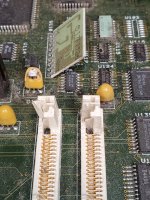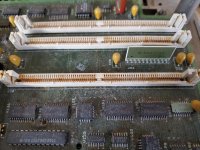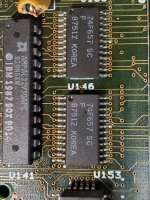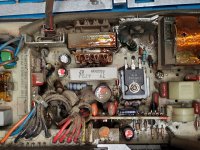A few weeks ago I posted an inquiry as to where I could obtain a floppy drive for this computer. As luck would have it a seller had a non-functional one and I purchased it for $50. The idea was to obtain the floppy drive, I didn't really care about the rest of the computer. I lucked out and the floppy drive does work so my original goal was met with this acquisition.
That said I would like to see about fixing this computer. So I powered it on and there was initial life and then it shut down. Thinking it was a problem with the hard disk I removed it and the system powered on, ran through its memory test, and showed the usual errors that come with such an old system. Then it just powered off.
I suspect the problem is in the power supply and, having a fully functioning system (except for the aforementioned floppy drive), I can swap in the known working power supply. Since the system is dirty I'll be performing a thorough cleaning but that will come over the weekend. In the meantime I thought I would post here for any suggestions. As I said the power supply is the first thing I suspect. I have the tools (DMM, scope, ESR meter) to troubleshoot it and the rest of the system. However I'll only be able to get to it as time permits so thinking I'd ask.
Oh, about the floppy drive. It's currently working but they're well known to fail over time. I think the capacitors leak on these. I've replaced them on the other drives I have so I know how to do so and have the experience. My question is: Should I? Or just use as is until it fails and then replace them? Leaking caps can cause PCB damage so I'm leaning towards proactively replacing them. But, given how difficult these are to come by, something about leaving something that works alone also sounds good. Advice?
That said I would like to see about fixing this computer. So I powered it on and there was initial life and then it shut down. Thinking it was a problem with the hard disk I removed it and the system powered on, ran through its memory test, and showed the usual errors that come with such an old system. Then it just powered off.
I suspect the problem is in the power supply and, having a fully functioning system (except for the aforementioned floppy drive), I can swap in the known working power supply. Since the system is dirty I'll be performing a thorough cleaning but that will come over the weekend. In the meantime I thought I would post here for any suggestions. As I said the power supply is the first thing I suspect. I have the tools (DMM, scope, ESR meter) to troubleshoot it and the rest of the system. However I'll only be able to get to it as time permits so thinking I'd ask.
Oh, about the floppy drive. It's currently working but they're well known to fail over time. I think the capacitors leak on these. I've replaced them on the other drives I have so I know how to do so and have the experience. My question is: Should I? Or just use as is until it fails and then replace them? Leaking caps can cause PCB damage so I'm leaning towards proactively replacing them. But, given how difficult these are to come by, something about leaving something that works alone also sounds good. Advice?




